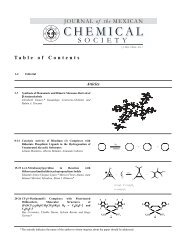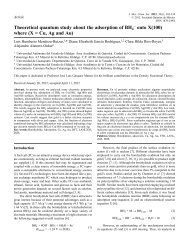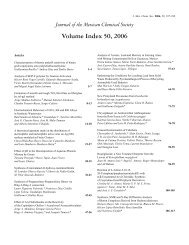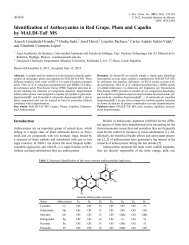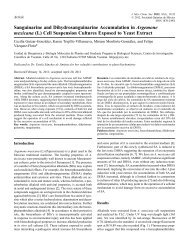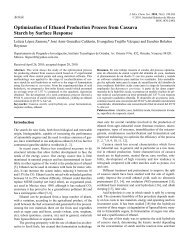Pincer Complexes. Applications in Catalysis
Pincer Complexes. Applications in Catalysis
Pincer Complexes. Applications in Catalysis
Create successful ePaper yourself
Turn your PDF publications into a flip-book with our unique Google optimized e-Paper software.
<strong>P<strong>in</strong>cer</strong> <strong>Complexes</strong>. <strong>Applications</strong> <strong>in</strong> <strong>Catalysis</strong> 341<br />
of these complexes have shown activity <strong>in</strong> the dehydrogenation<br />
of alkanes to alkenes. However, the extremely low reaction<br />
rates and the low turnover numbers or the <strong>in</strong>stability of<br />
the employed catalysts under the reaction conditions 16 has<br />
limited the use of these species.<br />
In 1976 Moulton and Shaw reported [1] for the first time<br />
the synthesis of the complex IrHCl{C 6H 3-2,6-(CH 2PBu t 2) 2}<br />
(11). They observed that this compound exhibited a high thermal<br />
stability, sublim<strong>in</strong>g without visible decomposition at temperatures<br />
as high as 180 o C. These results, led <strong>in</strong>dependently<br />
to the research groups of Jensen [16], Goldman [18] and<br />
Leitner [19] to the use of derivatives of this complex for its<br />
potential application as catalysts <strong>in</strong> the dehydrogenation of<br />
alkanes. Thus <strong>in</strong> 1998, Jensen and coworkers [20] reported the<br />
use of the dihydride rhodium complex RhH 2{C 6H 3-2,6-<br />
(CH 2PBu t 2) 2}(12) <strong>in</strong> the dehydrogenation of cyclooctane at<br />
150 o C, us<strong>in</strong>g tert-butylethylene as sacrificial hydrogen acceptor.<br />
This compound has been tested at reaction temperatures as<br />
high as 200 o C, show<strong>in</strong>g to be stable for periods of weeks.<br />
However the dehydrogenation reaction us<strong>in</strong>g this complex<br />
only afforded 1.8 turnovers at 200 o C. Further experiments,<br />
led Jensen and coworkers [21] to determ<strong>in</strong>e that it was <strong>in</strong> fact<br />
the iridium derivative IrH 2{C 6H 3-2,6-(CH 2PBu t 2) 2} (13) and<br />
not the rhodium complex (12) the best dehydrogenation catalyst.<br />
Thus, under the optimized conditions Jensen and coworkers<br />
were able to atta<strong>in</strong> turnover numbers of 720 at reaction<br />
temperatures of 200 o C, even though this complex exhibits<br />
excellent activity at temperatures as low as 150 o C (TON =<br />
82). Unfortunately, complex (13) is quickly deactivated by the<br />
formed product (product <strong>in</strong>hibition) [21].<br />
The complex IrH 2{C 6H 3-2,6-(CH 2PBu t 2) 2} (13), has been<br />
employed <strong>in</strong> the activation of C-H bonds of several substrates<br />
(vide supra) [21]; probably the most notable case be<strong>in</strong>g the<br />
dehydrogenation of l<strong>in</strong>ear alkanes to their correspond<strong>in</strong>g term<strong>in</strong>al<br />
alkenes (α-olef<strong>in</strong>s), be<strong>in</strong>g this the k<strong>in</strong>etically favored<br />
process. However, the same complex slowly catalyzes the isomerization<br />
of the term<strong>in</strong>al alkene to <strong>in</strong>ternal alkenes, be<strong>in</strong>g<br />
this the thermodynamic product [22].<br />
Further modifications <strong>in</strong> the PCP p<strong>in</strong>cer ligand, like<br />
chang<strong>in</strong>g substituents at the P moiety and different hydrogen<br />
acceptors has led to Goldman and coworkers [23] to <strong>in</strong>crease<br />
the efficiency of the catalytic system to a maximum of 68%<br />
selectivity for the term<strong>in</strong>al alkene <strong>in</strong> the catalytic dehydrogenation<br />
of n-octane with turnover numbers <strong>in</strong> the order of<br />
143. Further improvement to the system has been the elim<strong>in</strong>ation<br />
of the need of the sacrificial hydrogen acceptor, this<br />
achievement be<strong>in</strong>g the product of the jo<strong>in</strong> efforts of the Jensen<br />
and Goldman research groups, reach<strong>in</strong>g a 1000 turnovers<br />
under the optimized acceptorless conditions [24]. Further contribution<br />
by theoretical calculations [25] have led to the postulation<br />
of a tentative reaction mechanism through which complexes<br />
IrH 2{C 6H 3-2,6-(CH 2PBu t 2) 2} (13) and IrH 2{C 6H 3-2,6-<br />
(CH 2PPr i 2) 2} (14) carried out the alkane dehydrogenation both<br />
under hydrogen acceptor and acceptorless conditions [26].<br />
Recently, Kaska and coworkers [27] have reported a rigid<br />
PCP p<strong>in</strong>cer system based on antracene backbone (16), the iridium<br />
derivative of this ligand has demonstrated catalytic activity<br />
<strong>in</strong> the dehydrogenation of alkanes at temperatures as high<br />
as 250 o C without decomposition. Although even at this reac-






